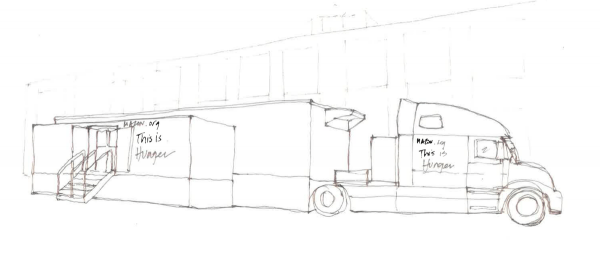Visiting Mazon: This is Hunger


There is a large trailer sitting inside of Prospect Park, across from the temporarily defunct Pavilion movie theater, and it will be there all weekend. From the outside, it looks similar to many of the movie trailers that camp out across the city, but this one is different. Inside you will find a highly-curated space from the non-profit organization known as Mazon. This is Hunger is an interactive installation that seeks to open people’s eyes to one of America’s most unsung calamities.
Mazon is a non-profit organization that categorizes itself as a “Jewish response to hunger.” In its 32-year history, it has been recognized as one of the leaders in addressing the issue of food insecurity in America. Unlike the international organization Feeding America or the local Food Bank of New York City, which focus their efforts on gathering and distributing food to the hungry, Mazon is an advocacy group whose focus is on addressing the issues that lead to hunger. Over the years, they have fought for things like free meals in public schools and standardizing meals-on-wheels programs across the nation. Even as they work to change policy on the government side they must change minds and raise awareness of stateside hunger amongst the public.
From their efforts to educate the public sprung the idea for This is Hunger, a photo and video exhibition that provides a message on wheels. You begin by entering the trailer, expecting a dull space full of vinyl walls and bright lights, but behind the velvet curtains is something more like a new age dining room. A long table is lined by about twenty chairs (the reason why you may want to reserve a free seat online) and the rest of the room is blank. The genius of the design is in the use of light projection to accomplish more with less. From the round orbs of light that serve as empty plates to the interview subjects who move around the room telling their stories, the exhibition is carried out with a fluidity and omnipresence that mimics the quiet, widespread plight of hunger.
After 15 minutes of passive observation, the audience is invited to move around the room, ask questions and look at portraits of people that could be neighbors or grandparents, but are instead victims of hunger. The space maintains a solemn aura of dim quietude throughout but the Mazon staff that guide you through the piece are refreshingly chipper.
The collective room quickly brought up the Trump administration, unwilling to believe that even something as non-partisan as hunger could be subject to political disputation. In fact, the most recent budget proposal from the Republicans looks to cut any state assistance to federal food stamp programs, which would mean even less money for many SNAP recipients to buy food. Even as Mazon is fighting to increase SNAP benefits and inclusivity, the White House is looking to cut funding to the welfare program. An interactive handout gets passed around the table. It places you in the shoes of someone who is struggling to stay nourished on SNAP benefits – should anyone be expected to feed themselves on 90 cents a meal – needless to say, all of us at the table felt depleted.
In the back of the trailer, there is a selfie booth, a space designed to spread awareness of the cause with a photo and a hashtag. Here, for the first time, people are laughing as they try to position the camera to take a shot of a large group of women. At every corner of the room, there is an iPad set up to have you sign a petition or donate to their cause. But it begs the question: is this an art installation or a fundraising drive? Like many installations, I left with opinions and emotions, but also a handful of reading material that takes me back to the Mazon website. Art is intended to begin a conversation and elicit thought. This is Hunger did not leave anything open for debate.
This exhibit will have covered 19 states and the district of Columbia by the time it is over. The flexible installation – literally expanding outward after it is parked – is designed to get close to people on the streets and deliver a grassroots message. I came in search of some more profound perspective on hunger, instead, I was just reminded of how imperfect our social security net can be.
If you miss it in Prospect Park there will be one more chance to see it in the city at Temple Israel of NYC on April 30.



